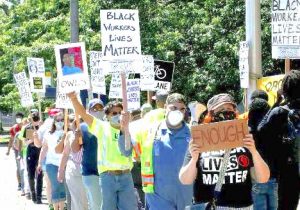Reparations: A Capitalist Diversion
The recent Red Flag piece on reparations may mislead workers about what capitalists are willing to concede in the current political climate. “Reparations may cost the rulers some cash…the US bosses are now scared enough to consider this a lesser evil.”
Two US Precedents
In 1946, the US Congress created the Indian Claims Commission to hear historic grievances and compensate tribes for lost territories
It awarded about $1.3 billion to 176 tribes and bands. For people on reservations, the money was often earmarked for tribal projects. However, actual funds only averaged about $1,000 per person. Most of the money was put into a trust account held by the US government.
Under the Civil Liberties Act of 1988, signed into law by President Ronald Reagan, the US government apologized for Japanese internment during World War II and provided $20,000 to each survivor to compensate for their loss of property and liberty. No compensation was given to the descendants of affected individuals.
Reparations for Slavery
Reparations for slavery is the making of amends through some type of compensation, apology, acknowledgement or other amends to slaves or descendants of slaves from the Atlantic slave trade in the US.
One major bill, the Commission to Study Reparation Proposals to African Americans Act, was proposed by Representative John Conyers (D-MI) unsuccessfully to the US Congress every year from 1989 until his resignation in 2017. The bill recommended the creation of a commission to study the “impact of slavery on the social, political, and economic life of our nation.” In the 116th Congress, 2019-2020, Representative Sheila Jackson Lee (D-TX) introduced HR #40, Commission to Study and Develop Reparations Proposals for African Americans.
It was introduced on 1/3/2019, and the House of Representatives Judiciary Committee held a hearing on 6/19/20.
The “40” is a reference to the 40 acres of land promised to former slaves by Union Army General William Sherman in 1865. The full allotment under Sherman’s Special Order No.15 was for 5.3 million acres of land to be redistributed to newly freed Black families. The offer was overturned by President Andrew Johnson, the 17th president, Abraham Lincoln’s successor, that same year. In the end, only 40,000 of the approximately 4 million enslaved people were settled on 400,000 acres before Johnson reversed the order.
HR #40 is not a reparation plan. It’s a bill, if passed, that would study what, if anything, the federal government owes the descendants of slaves, and how to implement that debt.
Reparations is a Capitalist Rabbit Hole
A rabbit hole is a detour from meaningful, purposeful work and efforts; and requires a great deal of time and work that produces no useful result. It conveys a sense of intensely captivating diversion. #HR 40 is a capitalist rabbit hole for workers.
Red Flag reports that 55% of all young Americans and a whole lot of older folks of all races have marched against the police terror that maintains the capitalist system of oppression and exploitation. They have faced rubber bullets, police batons, and tear gas in 99 US cities.
Let’s seize these opening opportunities to raise communist consciousness and recruit to ICWP.
—Bay Area Elder Comrade

Tukwila, WA, USA—200 rank-and-file Metro drivers and maintenance workers protest vicious long-term racism in the Kings County transit agency amidst another Covid-19 spike.
The Present Moment: Black Workers Lead
The article about reparations (page 2) in the last Red Flag was very informative. The beginning was very well written, capturing the reader’s imagination. It put forward a clear communist vision.
The facts were impressive: “Fifty-five percent of all young Americans, and a lot of older folks of all ‘races,’ have marched. They faced rubber bullets, police batons, and tear gas in ninety-nine US cities—and kept marching.”
Even more impressive: “A recent survey revealed that Black youth see revolution as a more plausible strategy for social change than voting.”
This is probably the biggest multiracial rebellion in US history. The militancy and heroism of the masses shows that objective conditions for a massive revolutionary upsurge are developing. The authors rightly claim that it “created a historic moment.”
Yet, it failed to define exactly what that moment is and what it means for the working class. It made no comment as to what looked so farfetched before seems more reachable now – especially with so many Black youth thinking of revolution!
This is a qualitative change. It makes revolution a lot more possible. Because of racist oppression and centuries of heroic struggle against it, Black workers are crucial to revolution.
This point could have been made more convincingly with examples of Black workers in the past giving militant leadership to the whole working class. As Black workers go, so will the rest of the US working class.
Hence, we should redouble our efforts to build a political communist base with more Black workers and recruit them to the Party, struggling to convince them of the crucial role they play and inspiring them to shoulder this historic responsibility.
After correctly stating that “The ruling class sees and fears the potential for revolution in the current situation,” the article diverges from what its real path should have been.
The important question is: Do we see in the rebellion the potential for revolution? If so, how can the Party grow from it?
Although the masses are open to revolution, mobilizing them for communism won’t be that easy. We face many ideological challenges.
There are different “revolutionary” ideologies – anarchism, anarcho communism, democratic socialism, socialism, benign capitalism – percolating among the masses. To mobilize them for communism we need to defeat these ideologies. Too much space was dedicated to “Reparations,” and not to what the masses are debating.
Addressing this would prepare our members and base for this struggle, preventing their disillusionment when things don’t happen quickly.
Also: capitalism is not a dying system. Capitalism has long outlived its historical usefulness. Although in a severe crisis of overproduction and the falling rate of profit, the capitalists will launch world war to rejuvenate it. Only communism can destroy it.
Finally, this is not a revolutionary movement. It has revolutionary potential because its participants can be won to fight for communism. The only revolutionary movement is ICWP mobilizing the masses for communism.
—Comrade in USA

